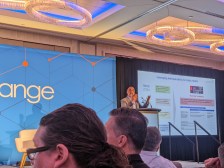HHS targets health data blocking in new contracting guide

The Department of Health and Human Services issued an electronic health records contracting guide Monday to help health care providers avoid buying technologies or services that may ultimately prevent or limit their ability to share patient data with other systems.
In spite of HHS’ Office of the National Coordinator for Health IT’s dedicated promotion of EHRs over the past decade, it’s struggled more recently with bad actors in the health IT community who engage in data blocking — when a health IT vendor purposefully tries to interfere with the exchange of health data to another entity, typically for competitive reasons.
ONC and the Centers for Medicare and Medicaid Services developed the contracting guide — “EHR Contracts Untangled: Selecting Wisely, Negotiating Terms, and Understanding the Fine Print” — to combat such behavior, because although data blocking can and does occur at the technology or service levels, it most often starts deep in the language and terms of a contract.
“The new EHR contracting guide is a key resource that will help providers address data blocking and other challenges as they continue to adopt and leverage health IT to improve the way they deliver care,” ONC National Coordinator Vindell Washington and CMS acting Administrator Andy Slavitt wrote in a blog post. “In today’s EHR marketplace, many vendors use ‘standard form’ contracts when offering their products and services. Providers all too often agree to these contracts – which are prepared from the vendor’s perspective – without fully understanding the ‘fine print’ or without negotiating rights and obligations that can ensure that the technology will meet their needs and expectations.”
HHS hopes the new guide will help providers “ask the right questions” and better communicate requirements when selecting an EHR. It also promotes connectivity and fights against common contractual data blocking practices, like “unanticipated connection fees, restrictions on data exchange, or contract terms that prevent users from reporting and sharing information about the performance of their EHRs,” Washington and Slavitt wrote.
“The guide offers specific strategies to help providers as they plan for the purchase of an EHR system and negotiate key terms with their EHR vendors,” the post says. “In short, this guide helps hospitals and doctors cut through the clutter, and assists them in implementing a new EHR system in a way that supports their workflow and their patients.”
ONC previously released a guide on key EHR contracting terms in 2013.
In conjunction with National Health IT Week, which runs through Sept.30, ONC also issued an expanded Health IT Playbook that will serve as an evolving collection of tools, resources and guides to help providers in their journey to implementing health IT.
“I know from my experiences practicing emergency medicine and managing information technology for a health system how helpful practical tools can be for clinicians and health care administrators as they navigate the purchase and use of health IT,” Washington said in a statement. “The EHR contract guide and the Health IT Playbook incorporate feedback we have heard from the provider community about the need for clear, reliable information about EHR contracts and user-friendly, specific tools for how to get the most out of health IT to better manage patient health and care.”
President Barack Obama acknowledged in a letter Monday the progress the nation has made over his two terms around health IT.
“When clinicians, researchers, individuals, and families have access to the tools, information, and resources they need, everyone can lead safer and healthier lives. During National Health IT Week, we recommit ourselves to improving the health of our citizenry using the breakthrough technologies of our time and reaching for the next frontier of innovation,” he wrote.
He added: “Though there is more to be done to realize a healthcare system that fits each of our needs, I am confident that if we continue working together, we can build a future of greater health and prosperity for coming generations.”






